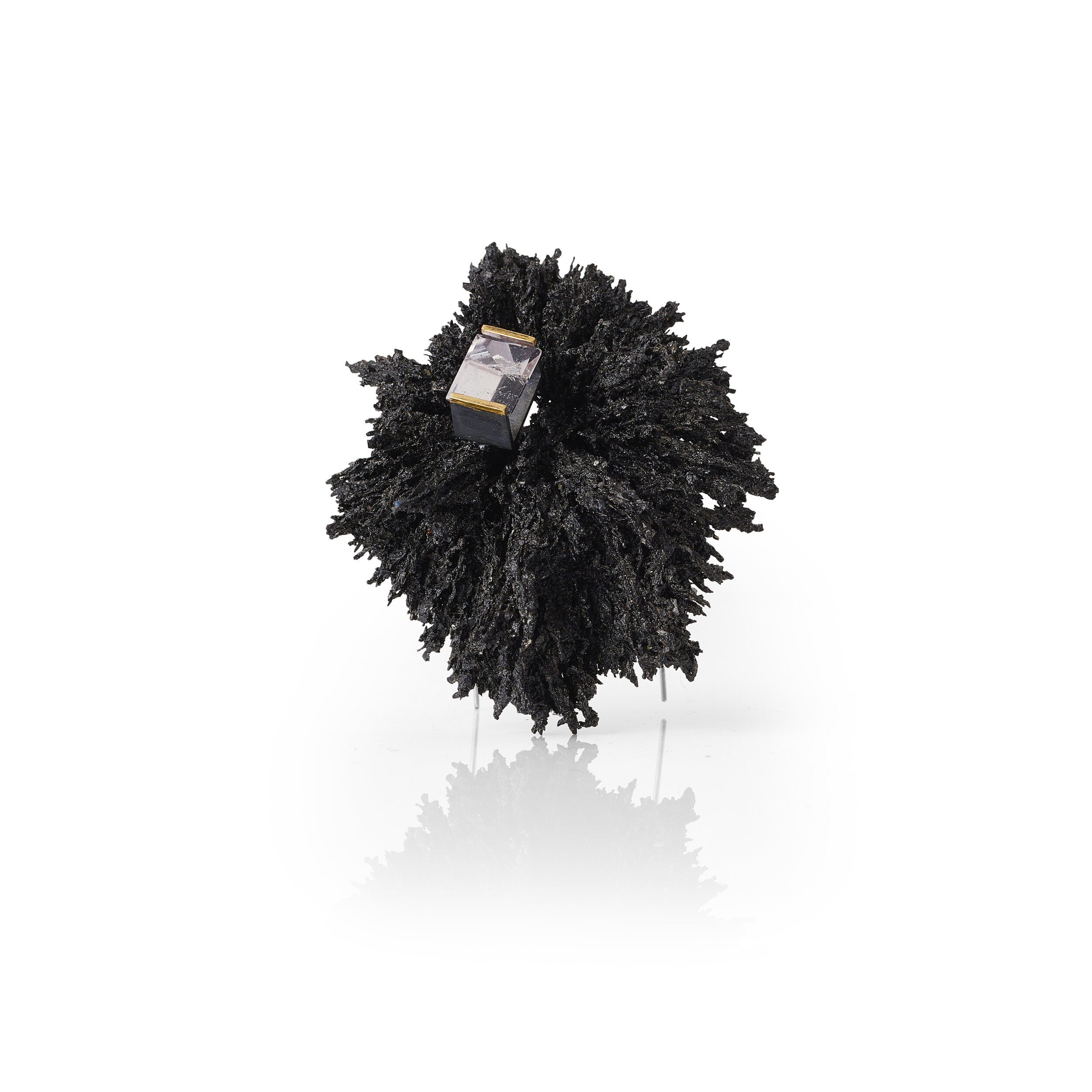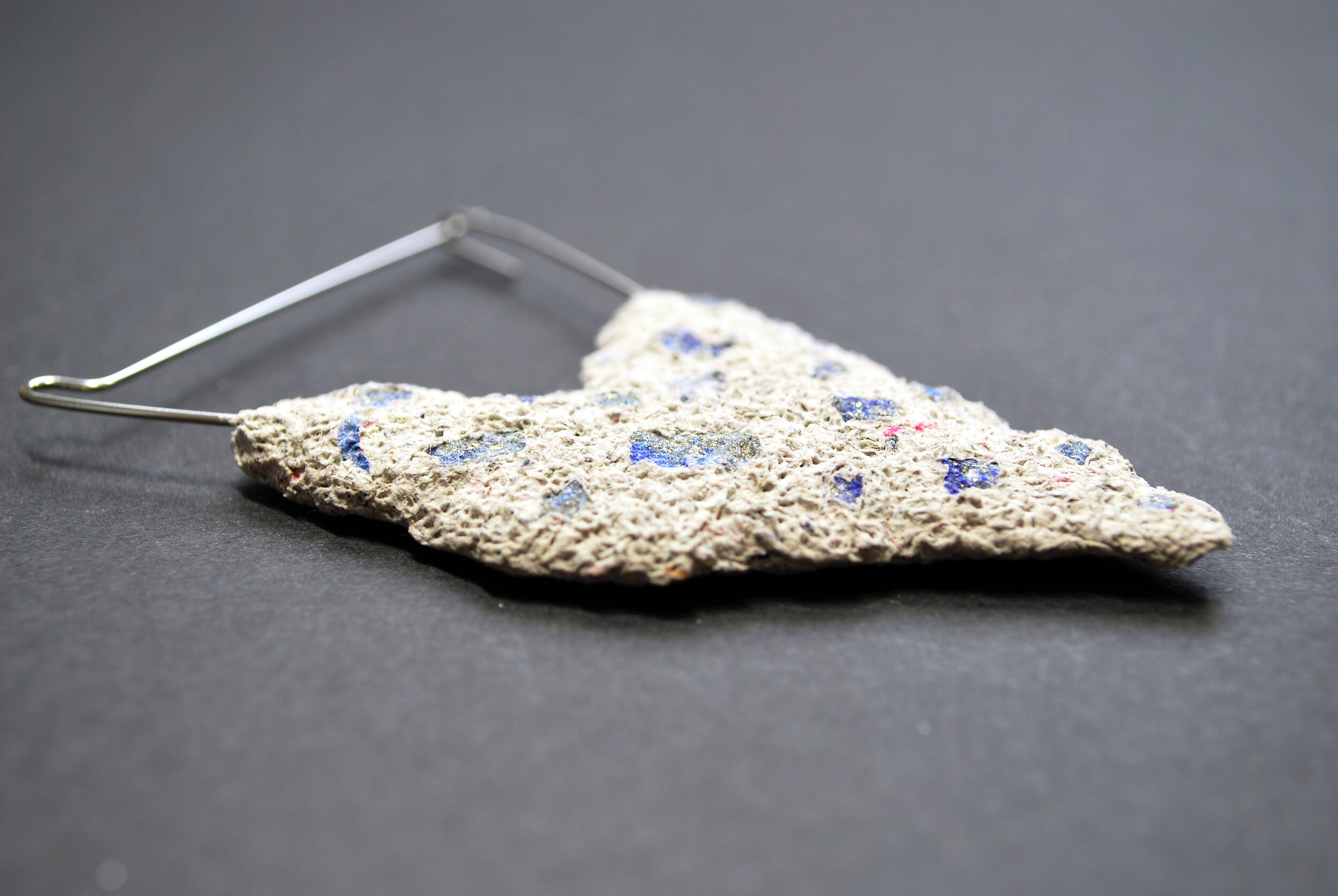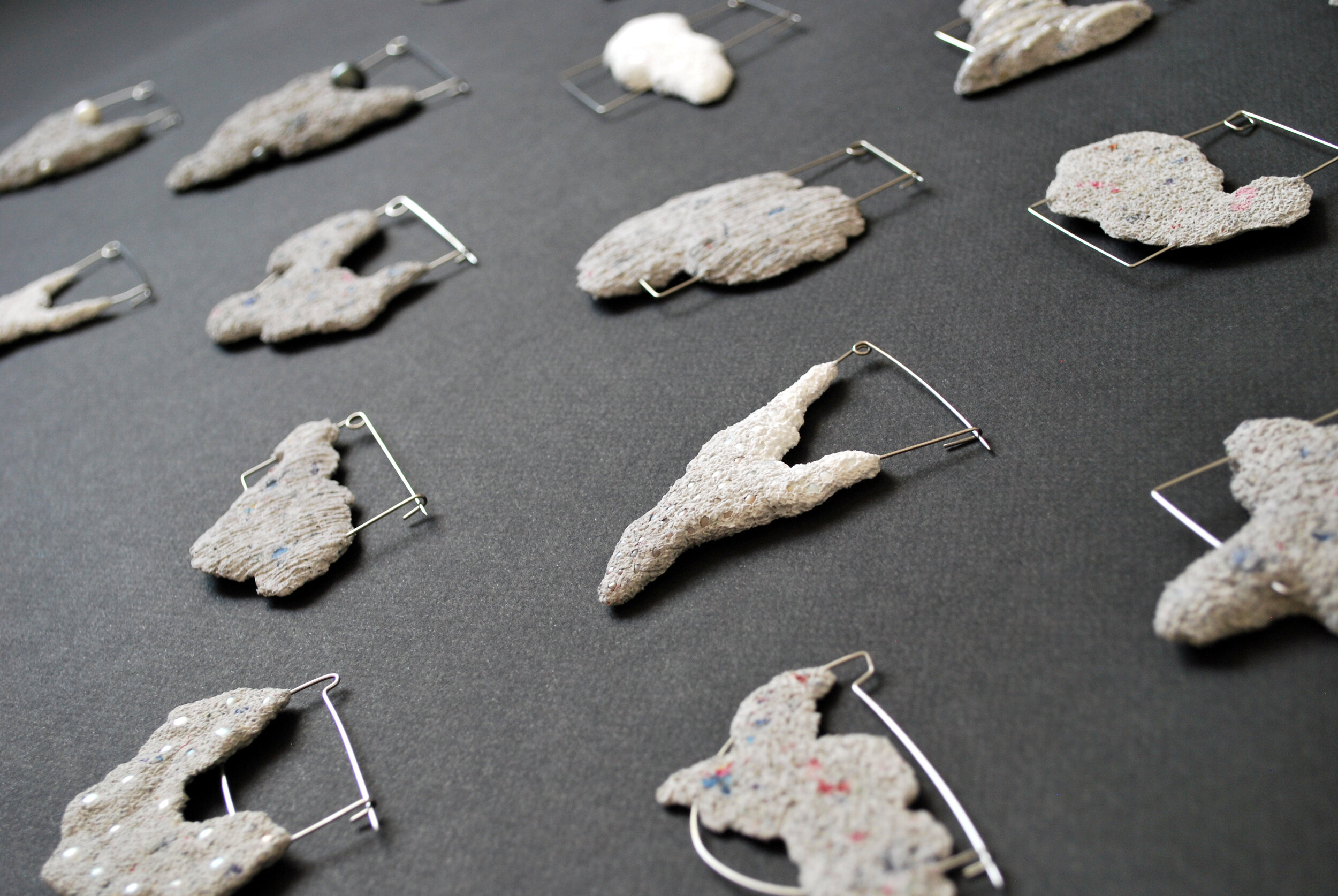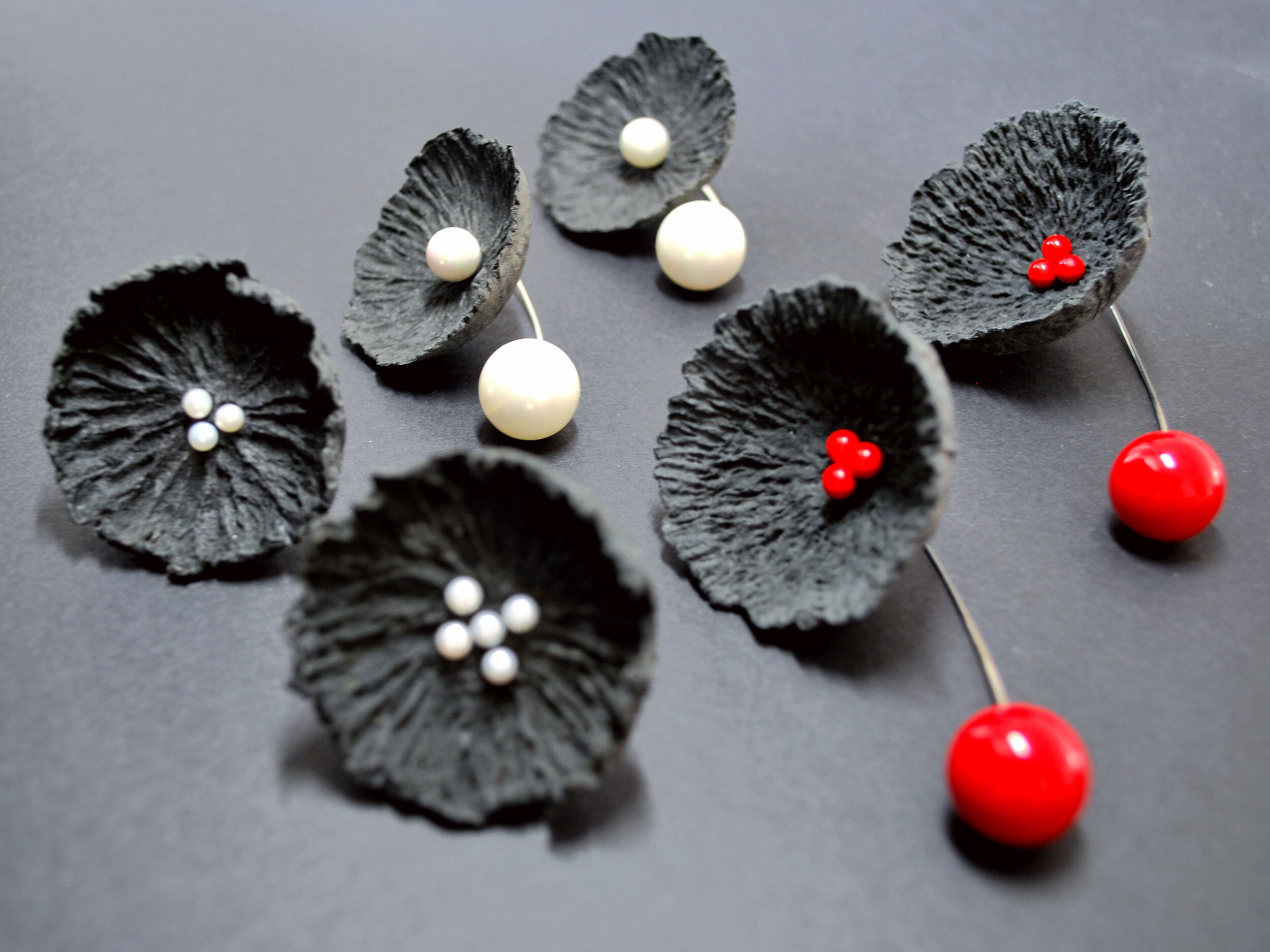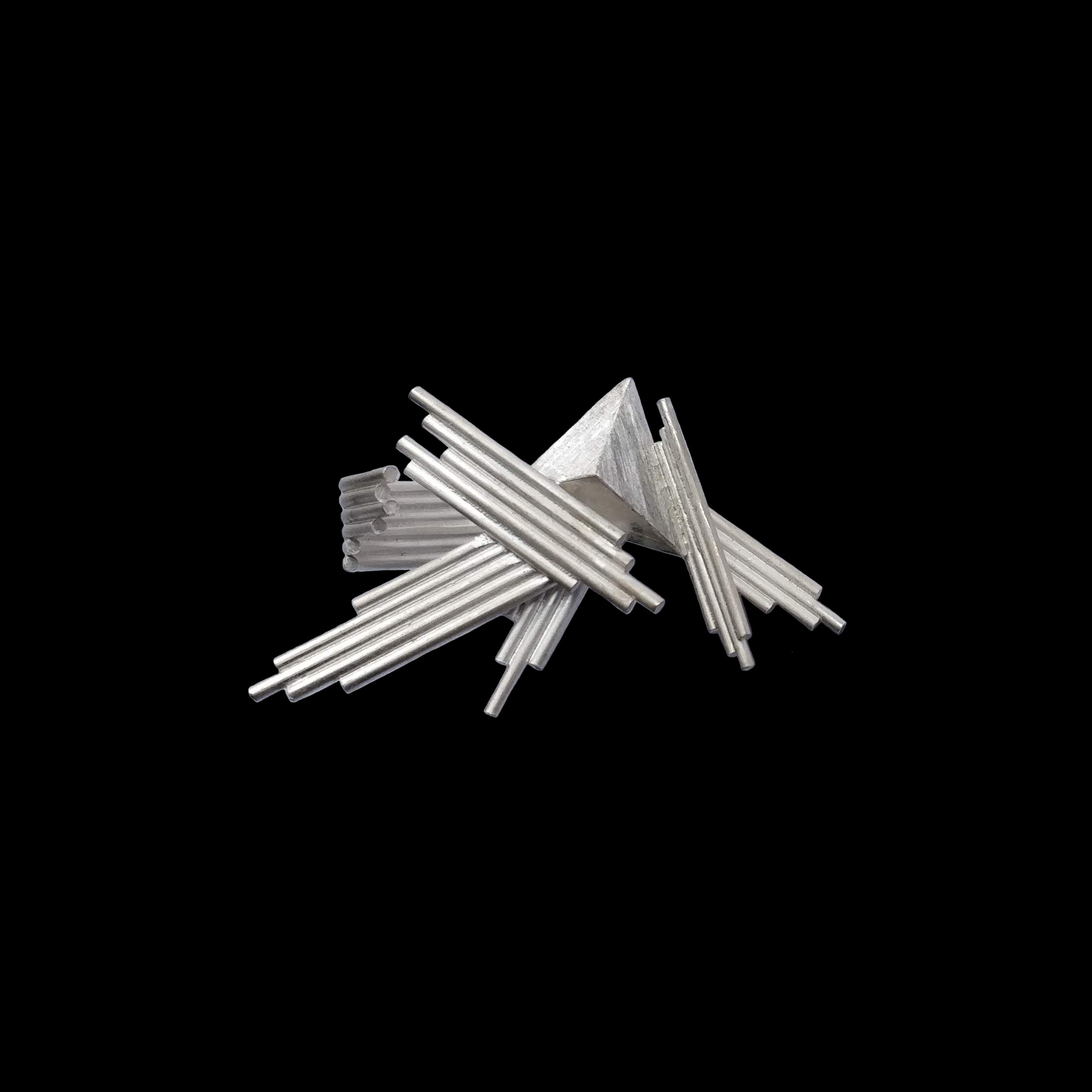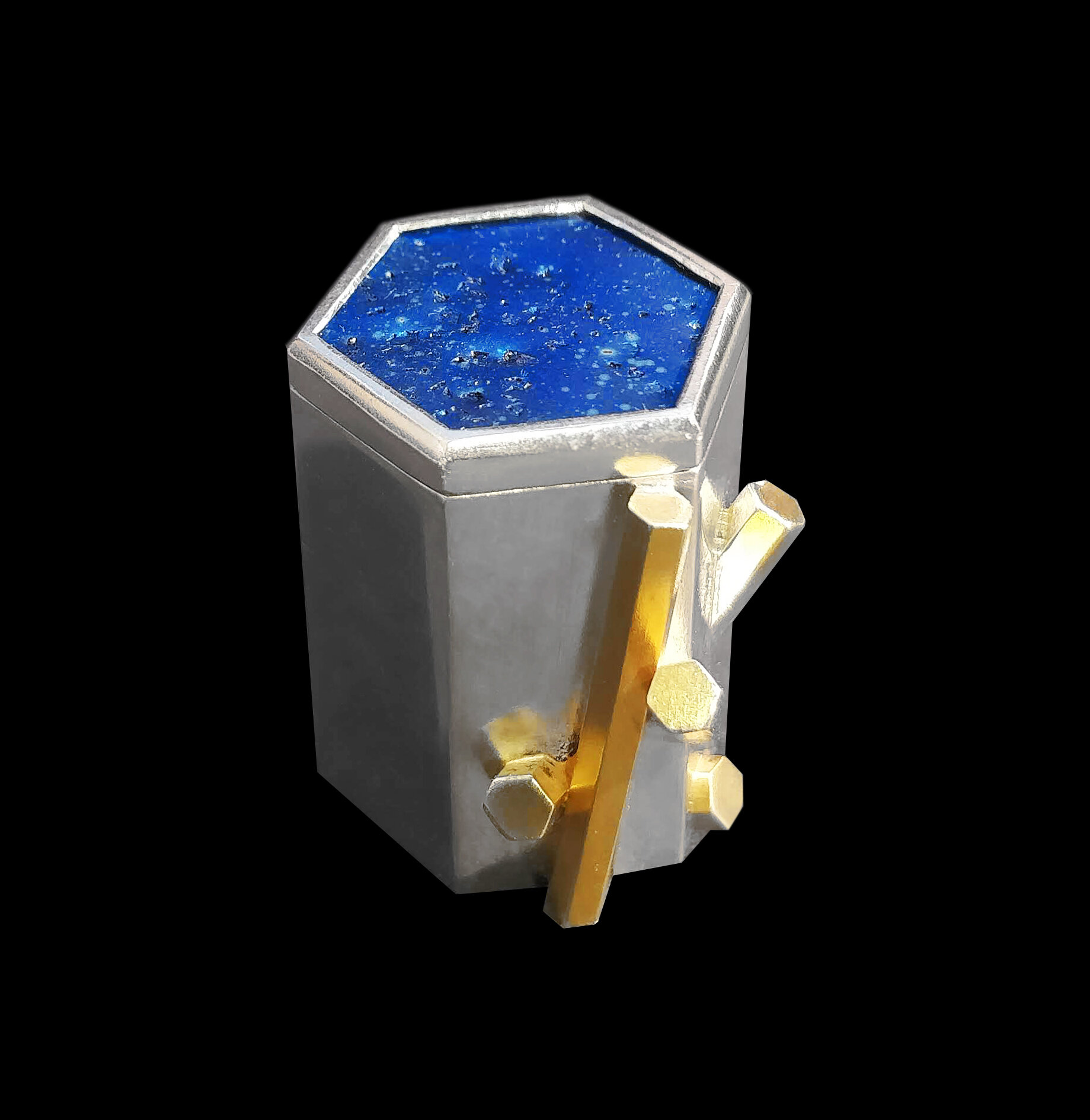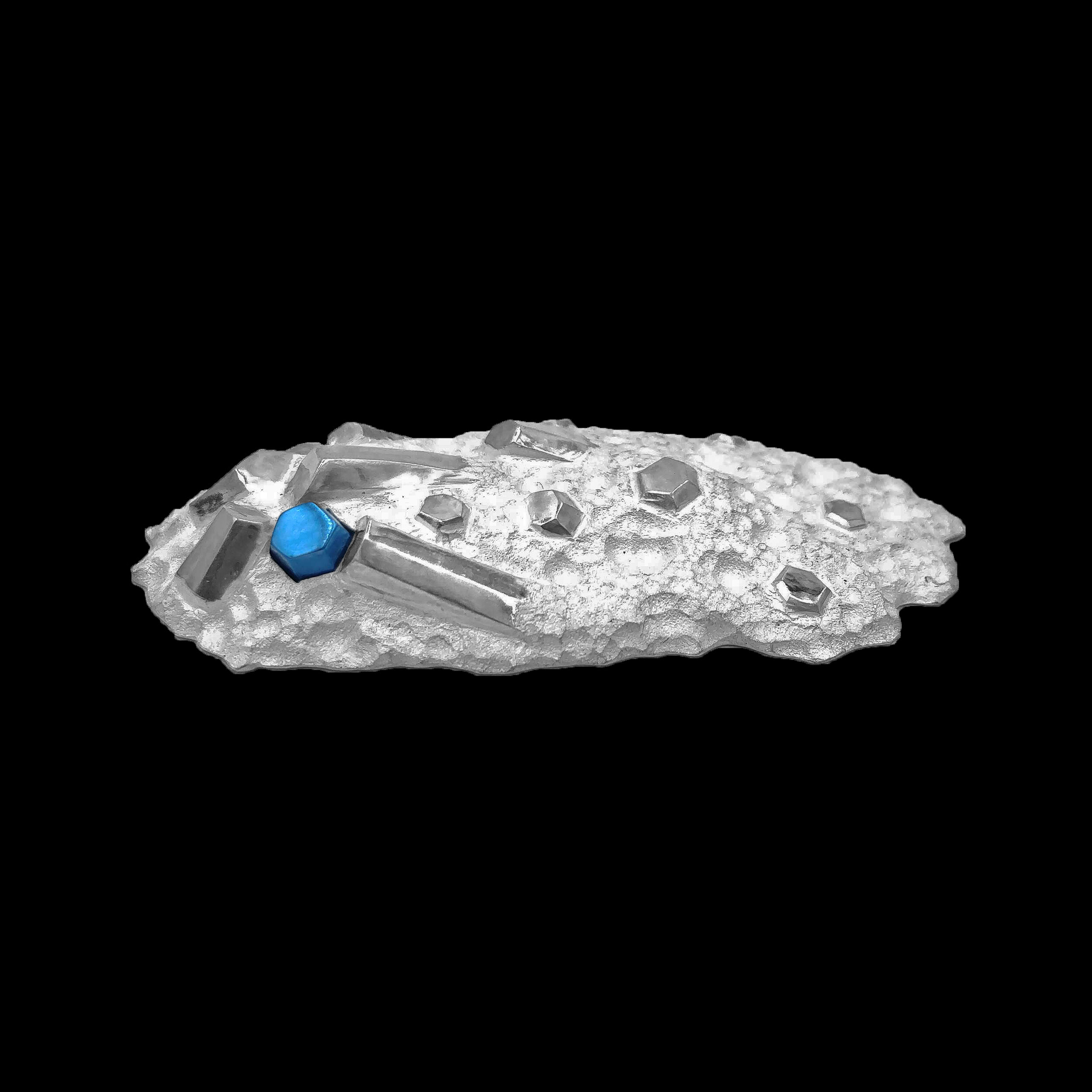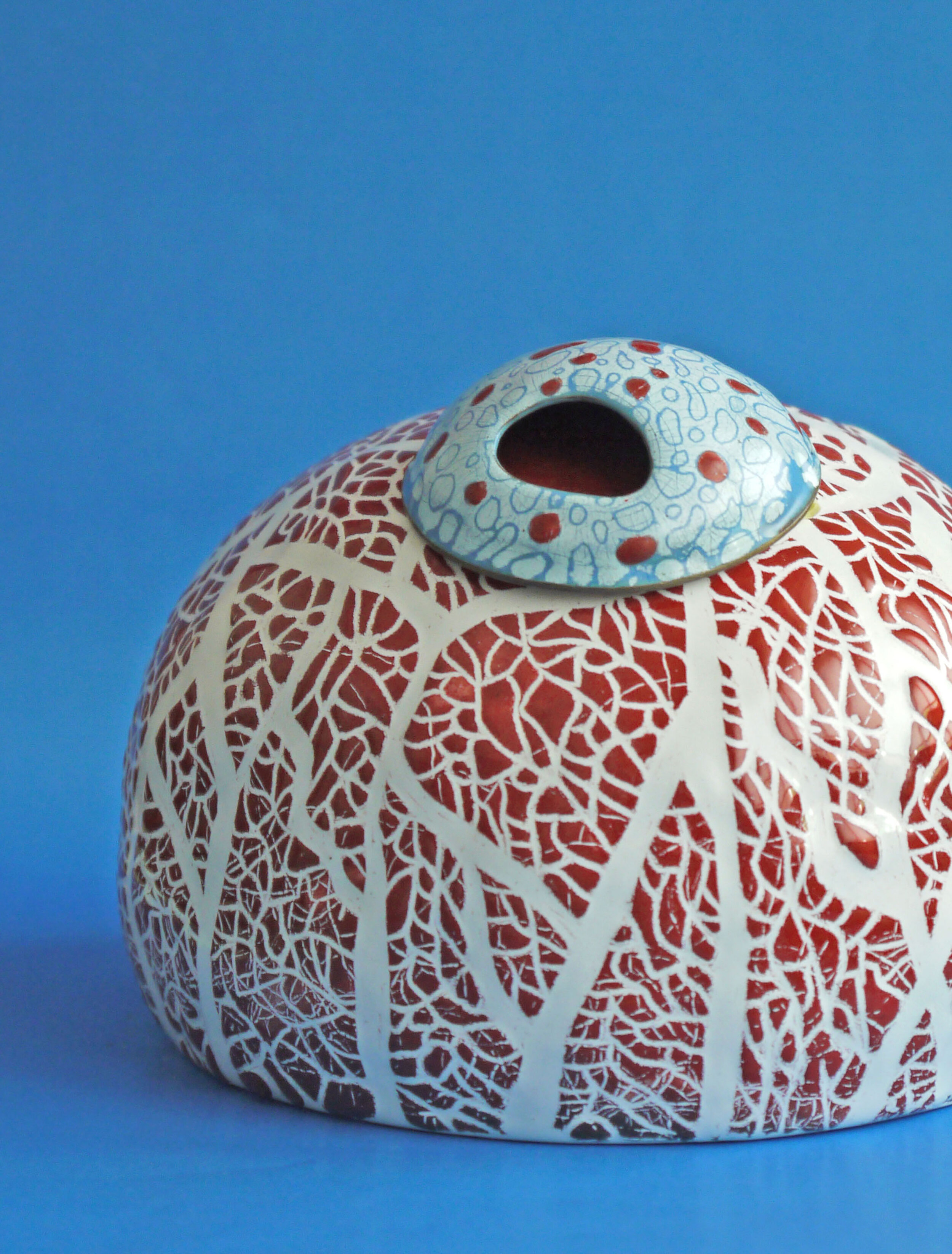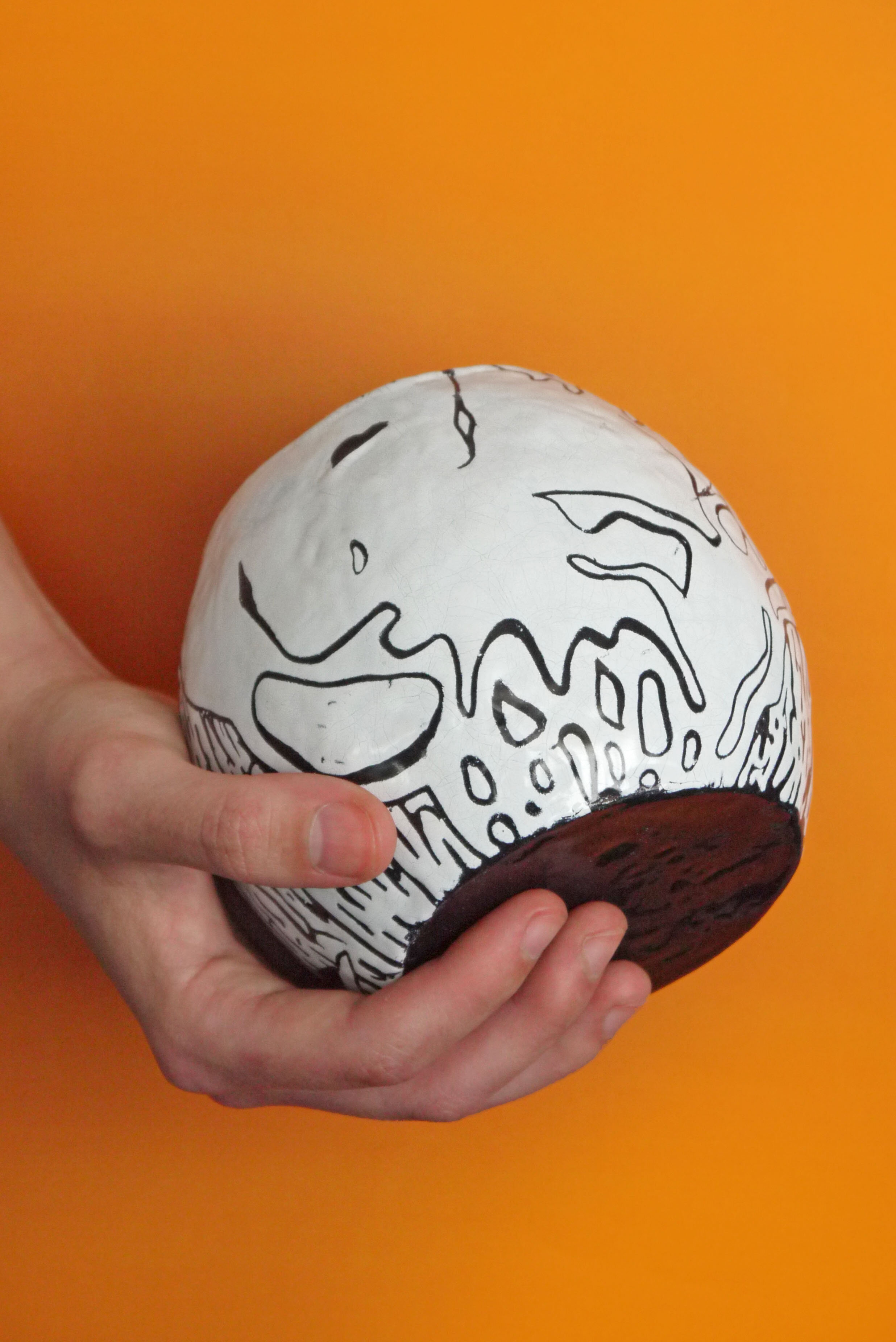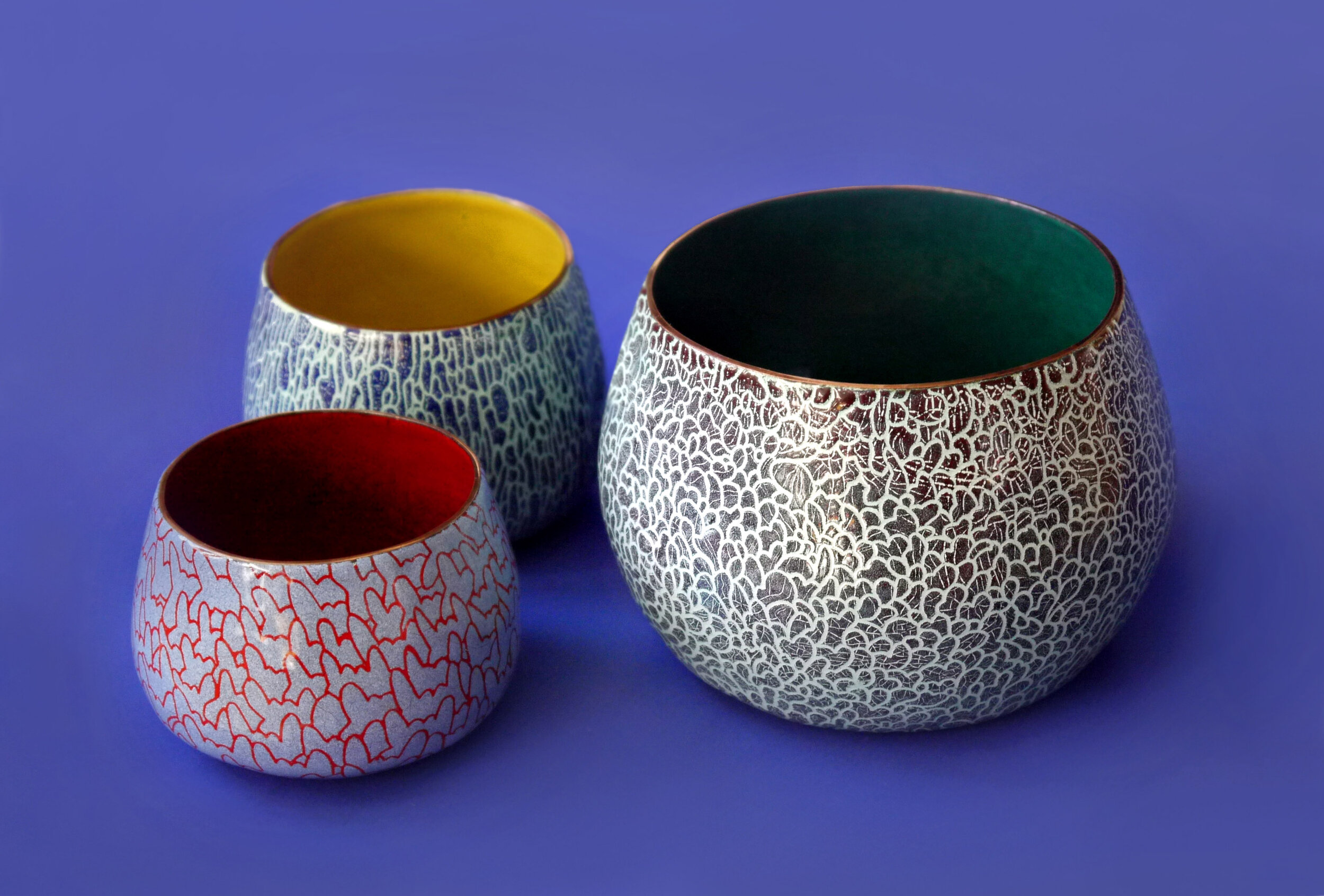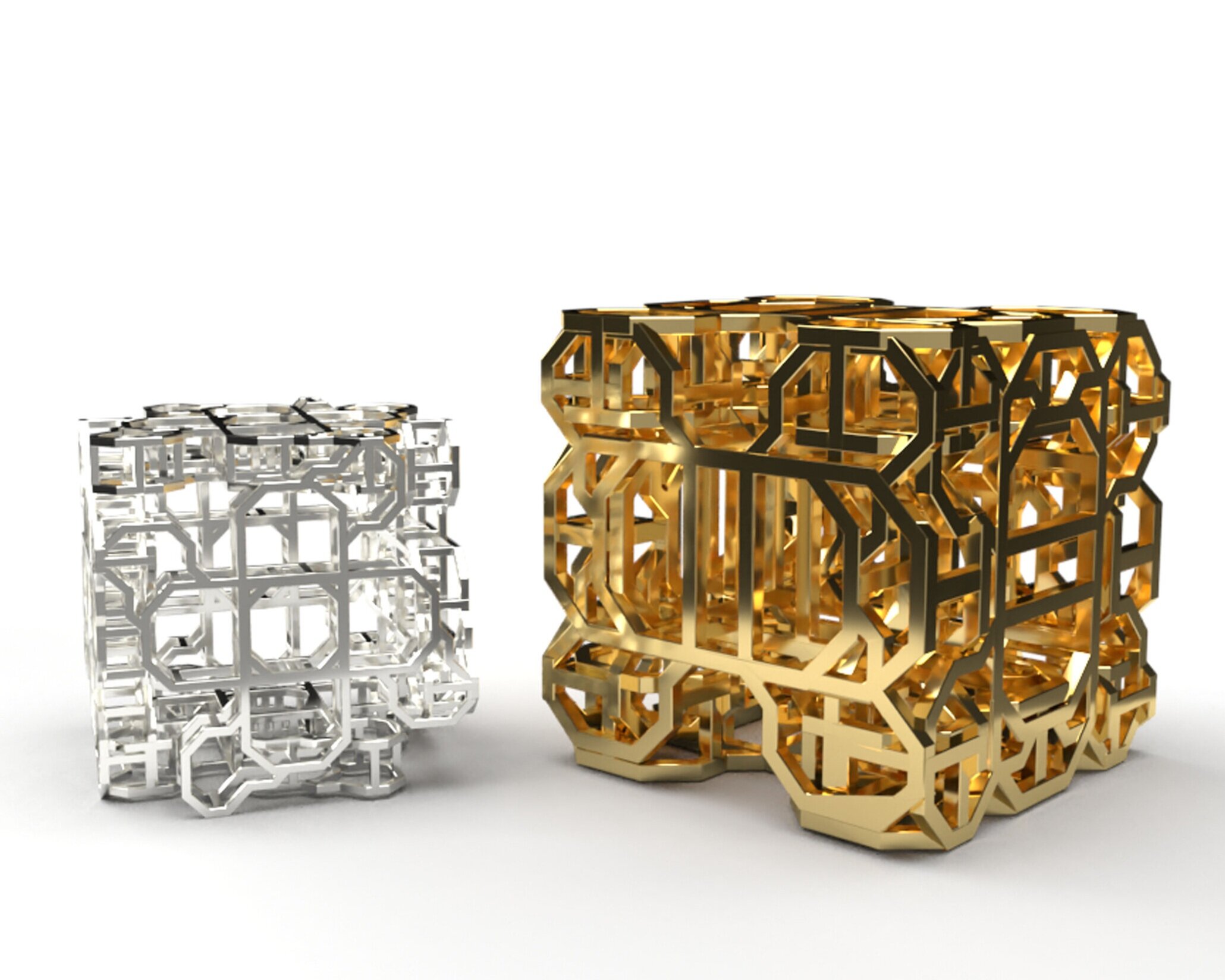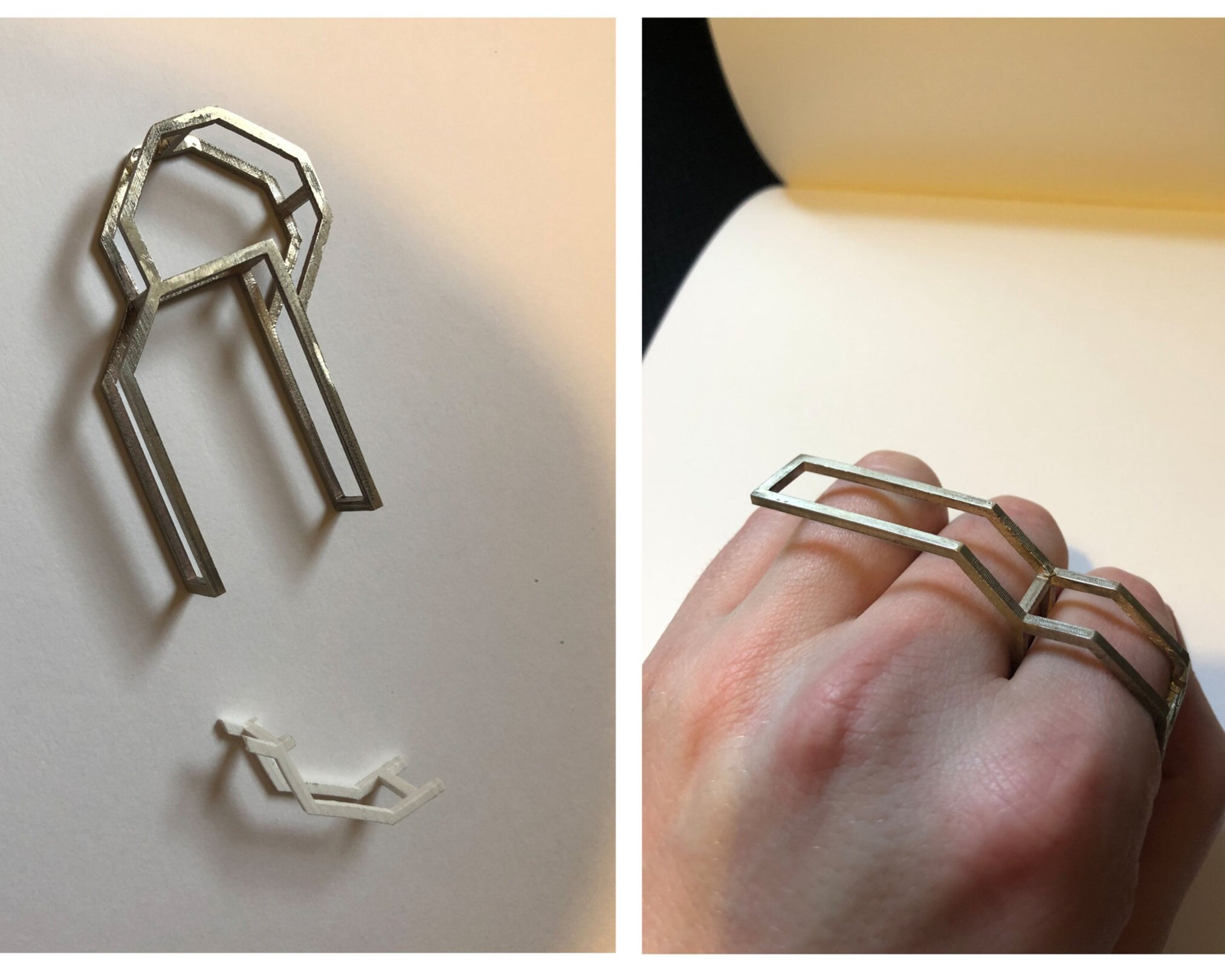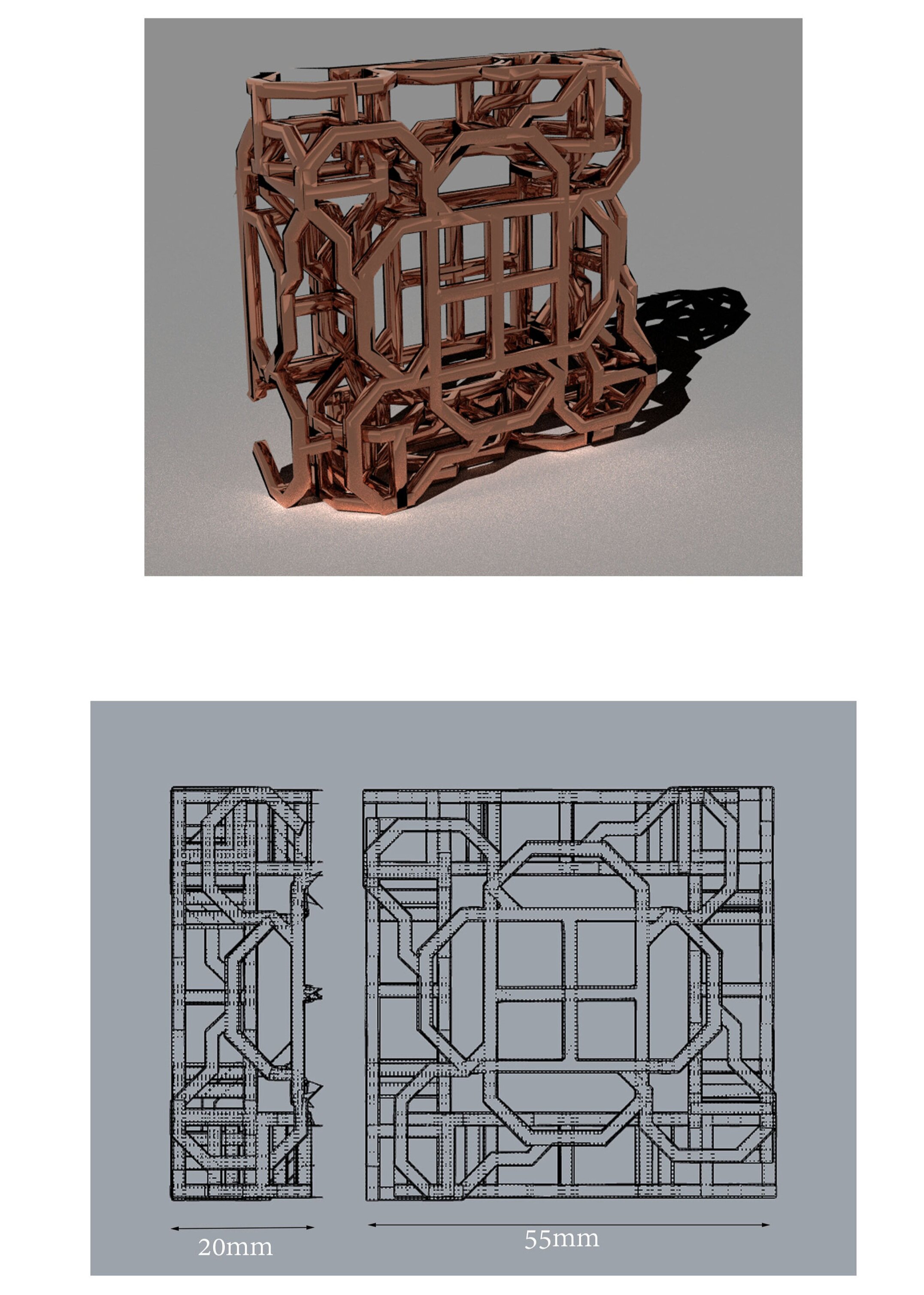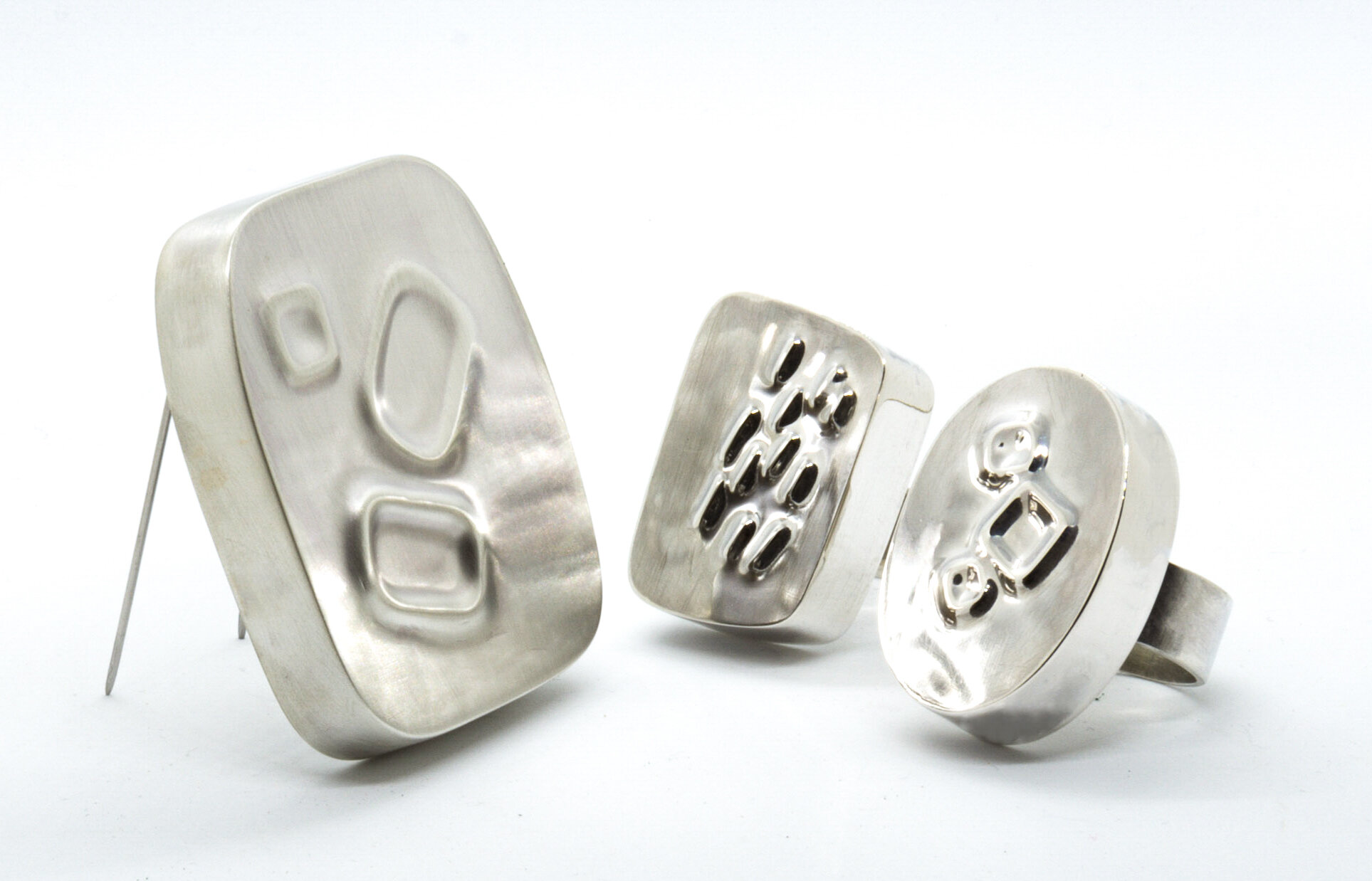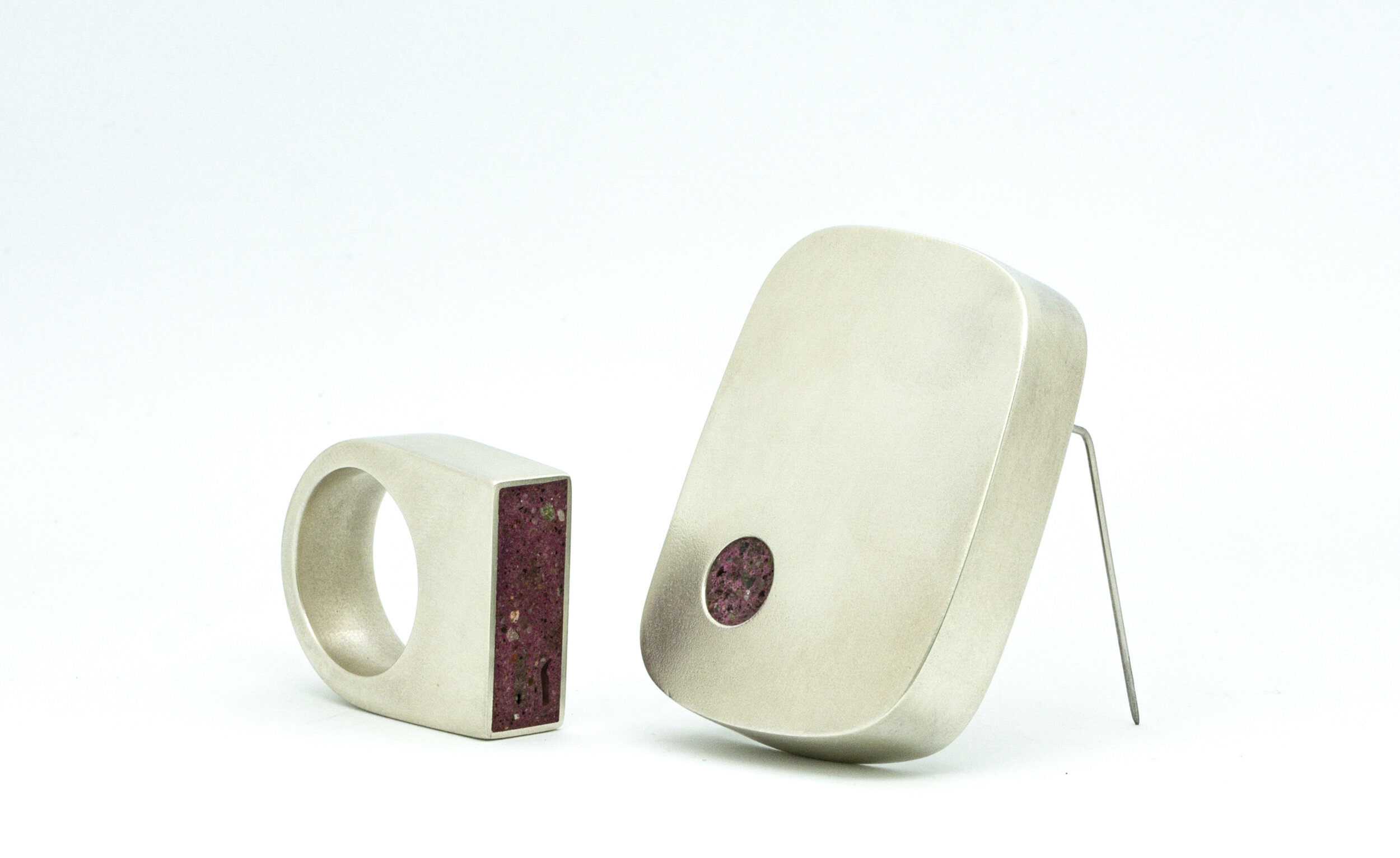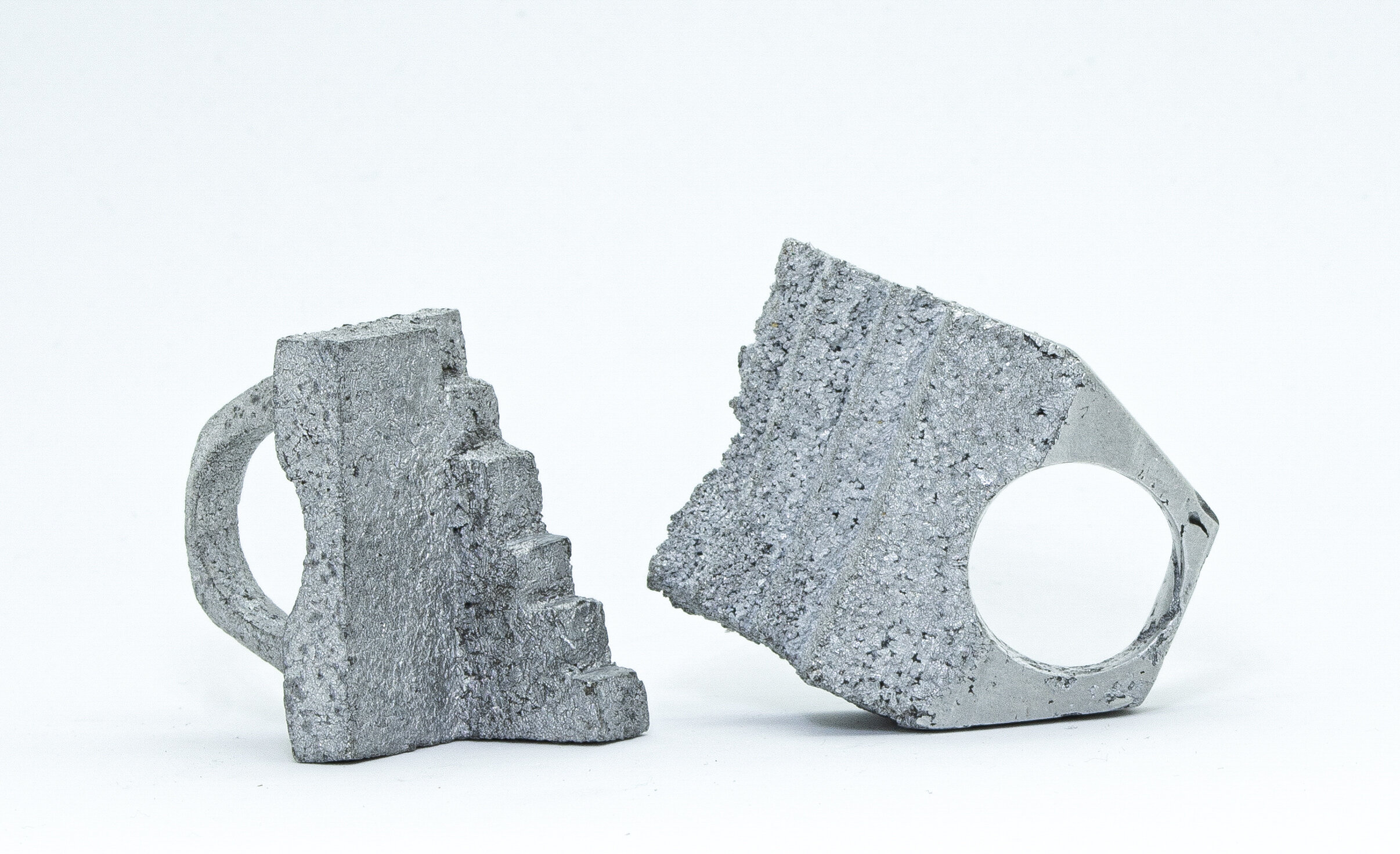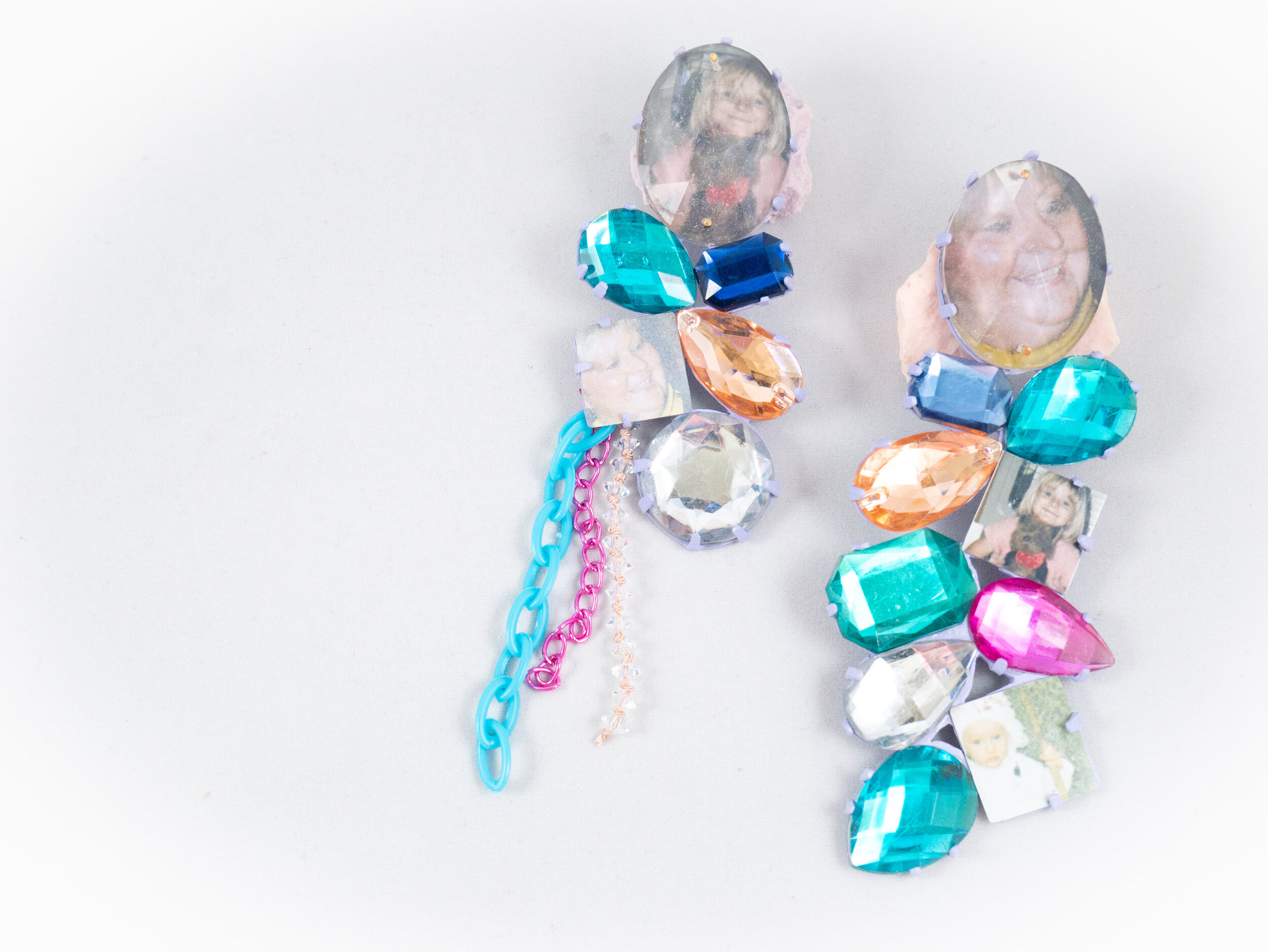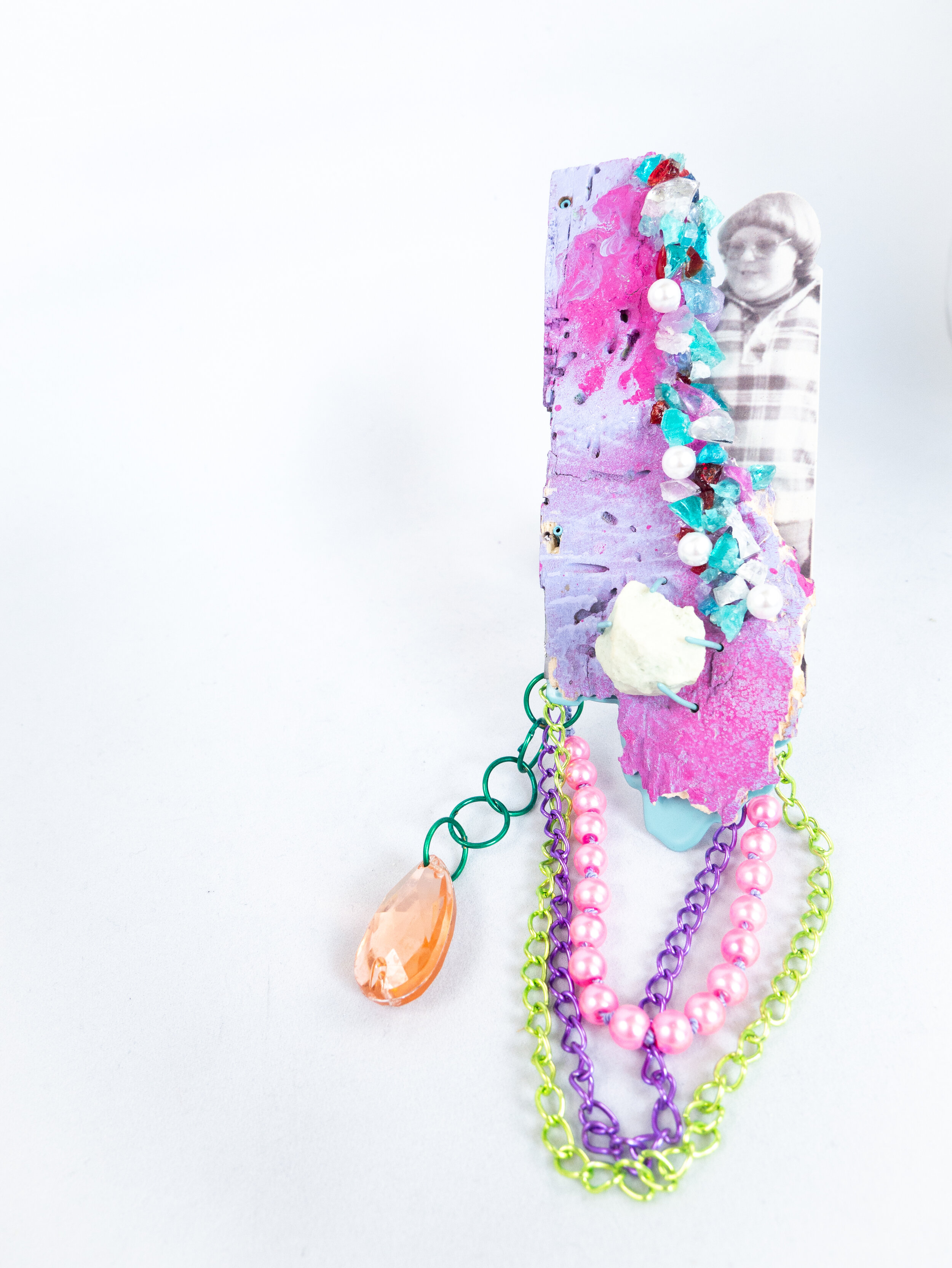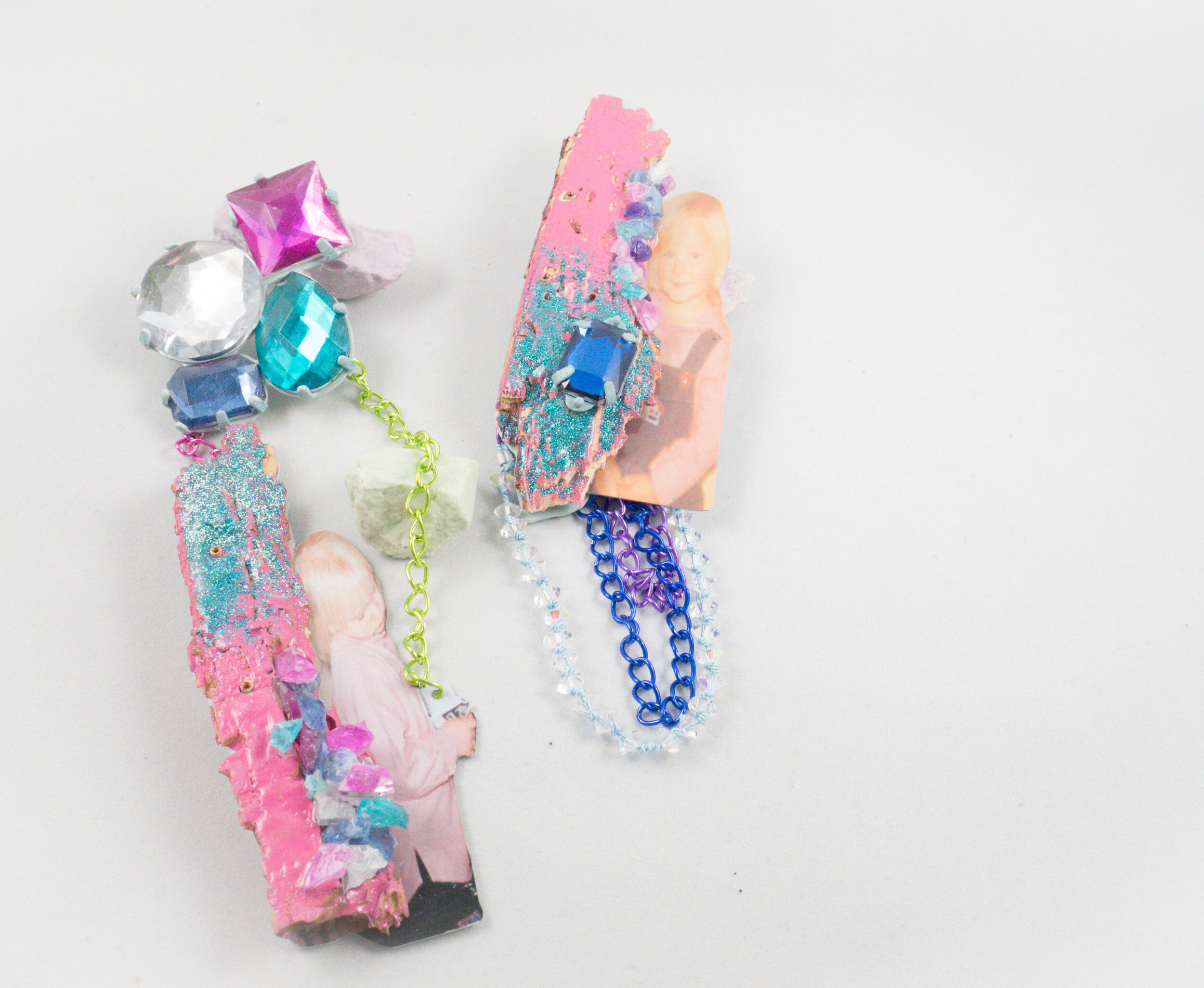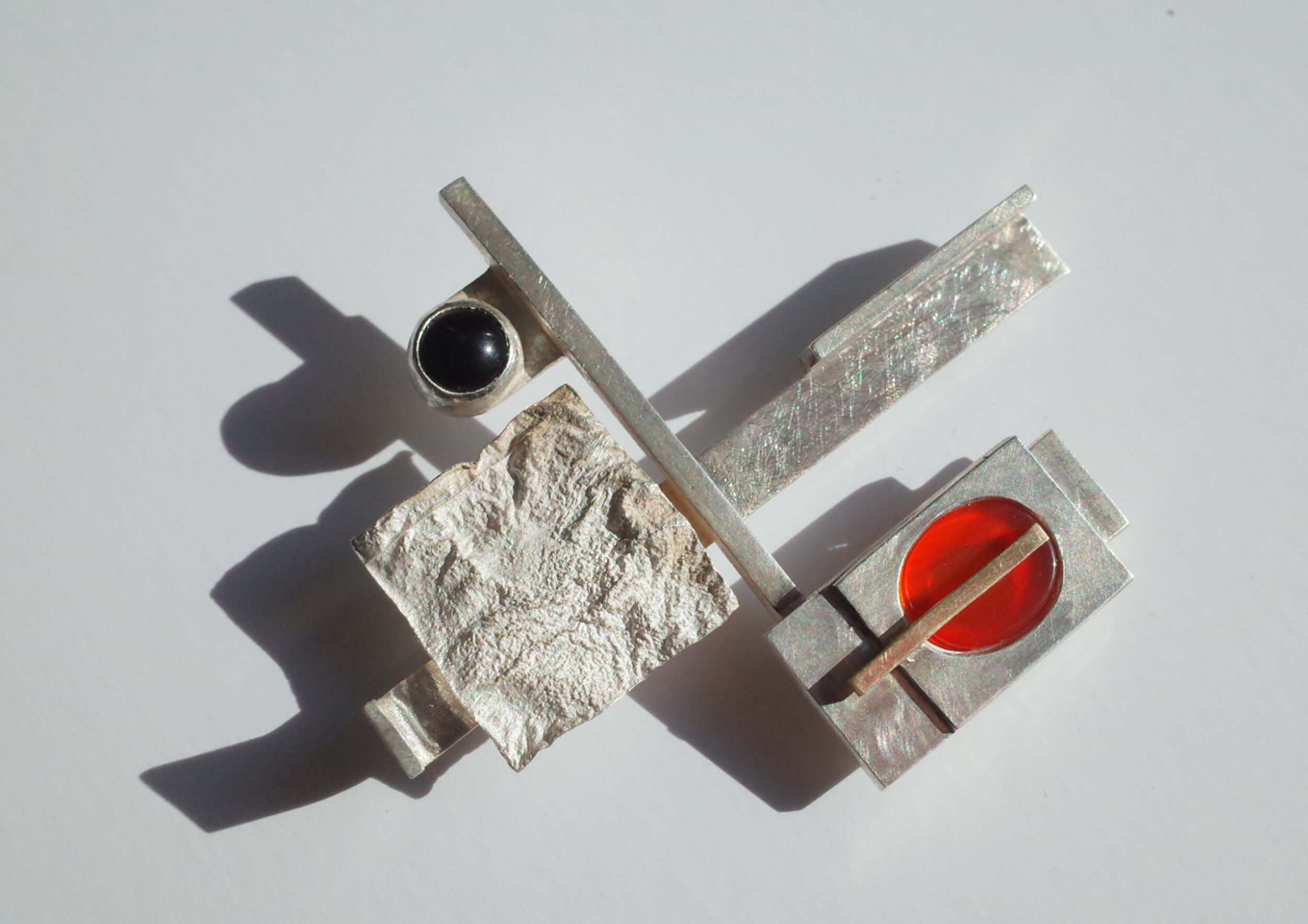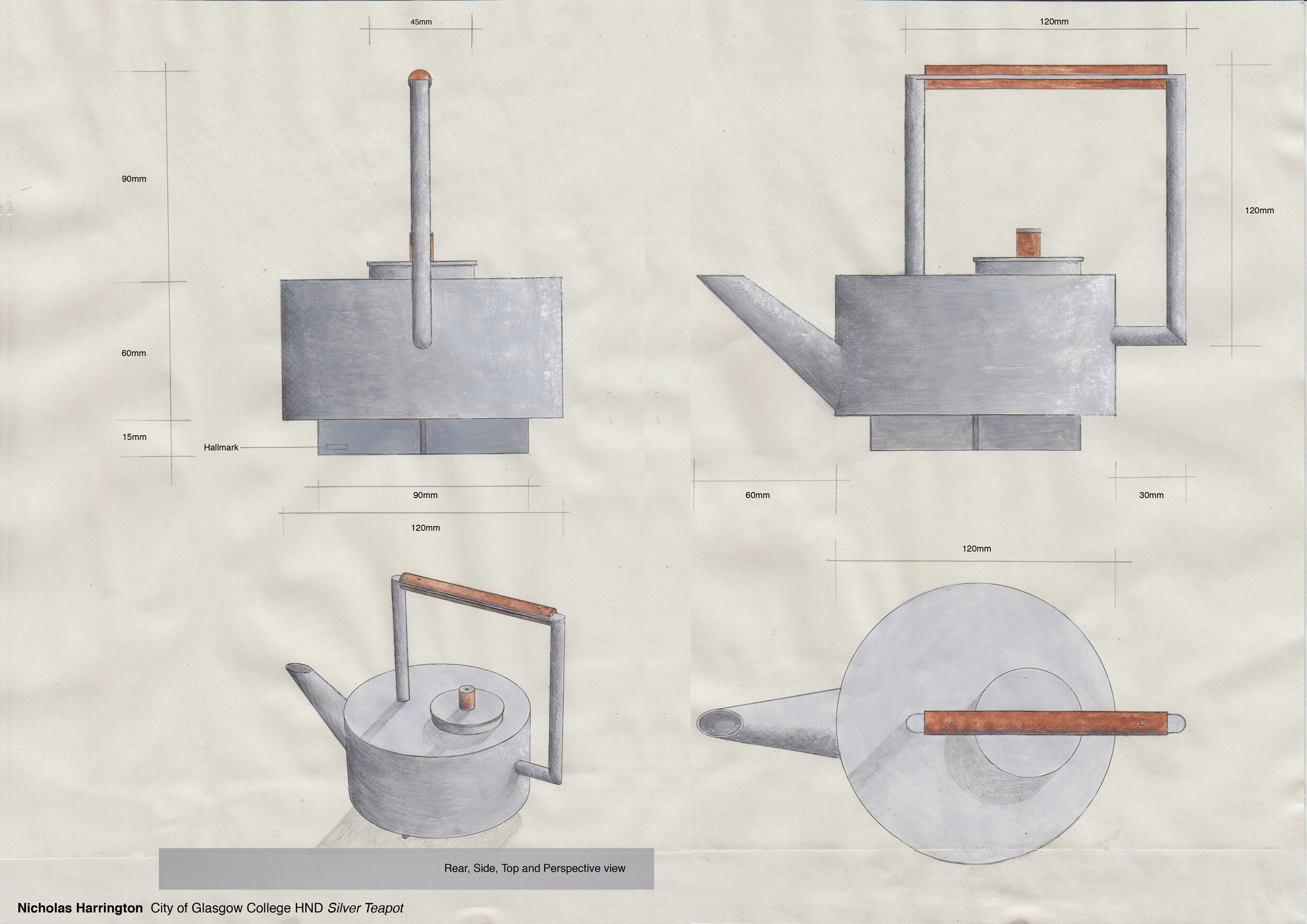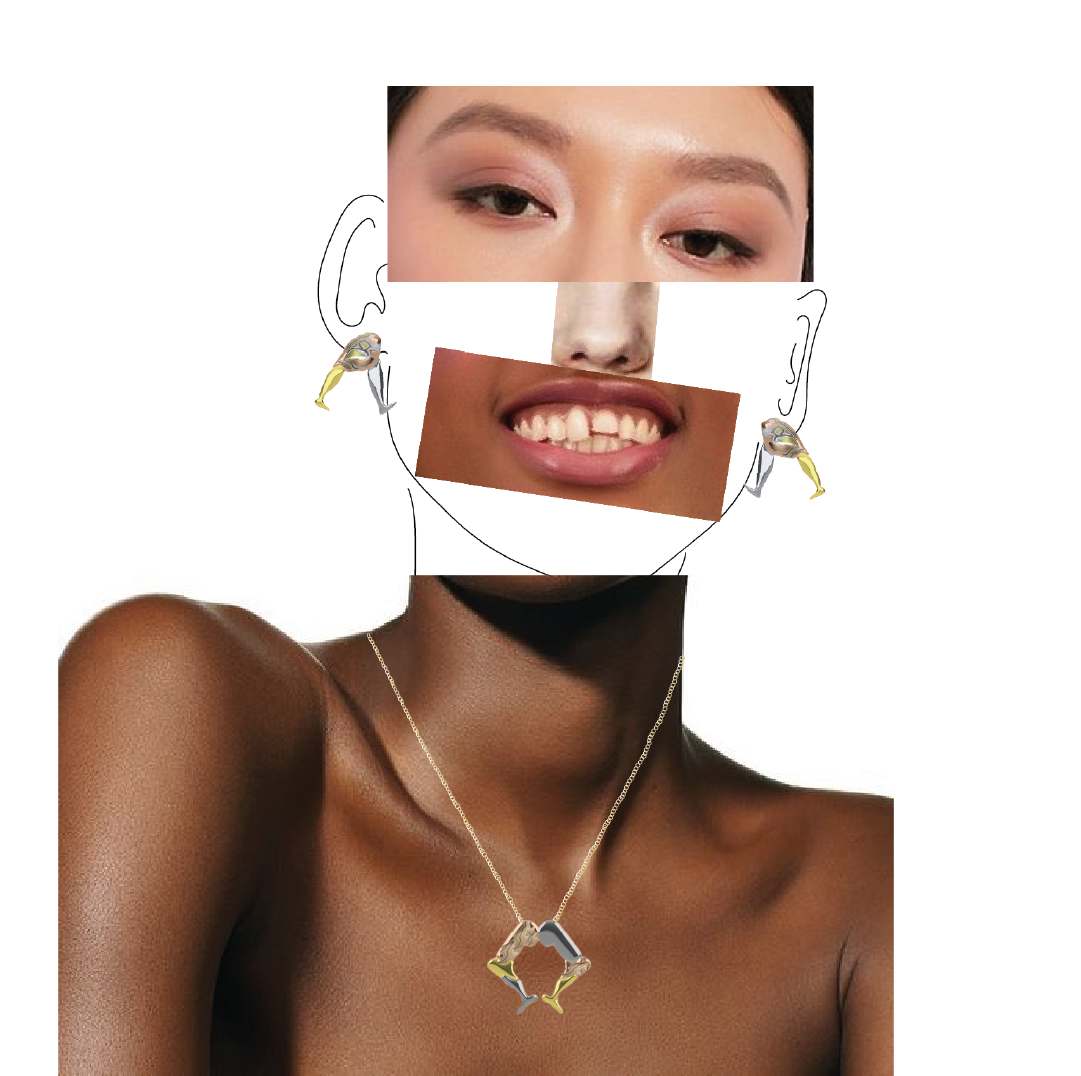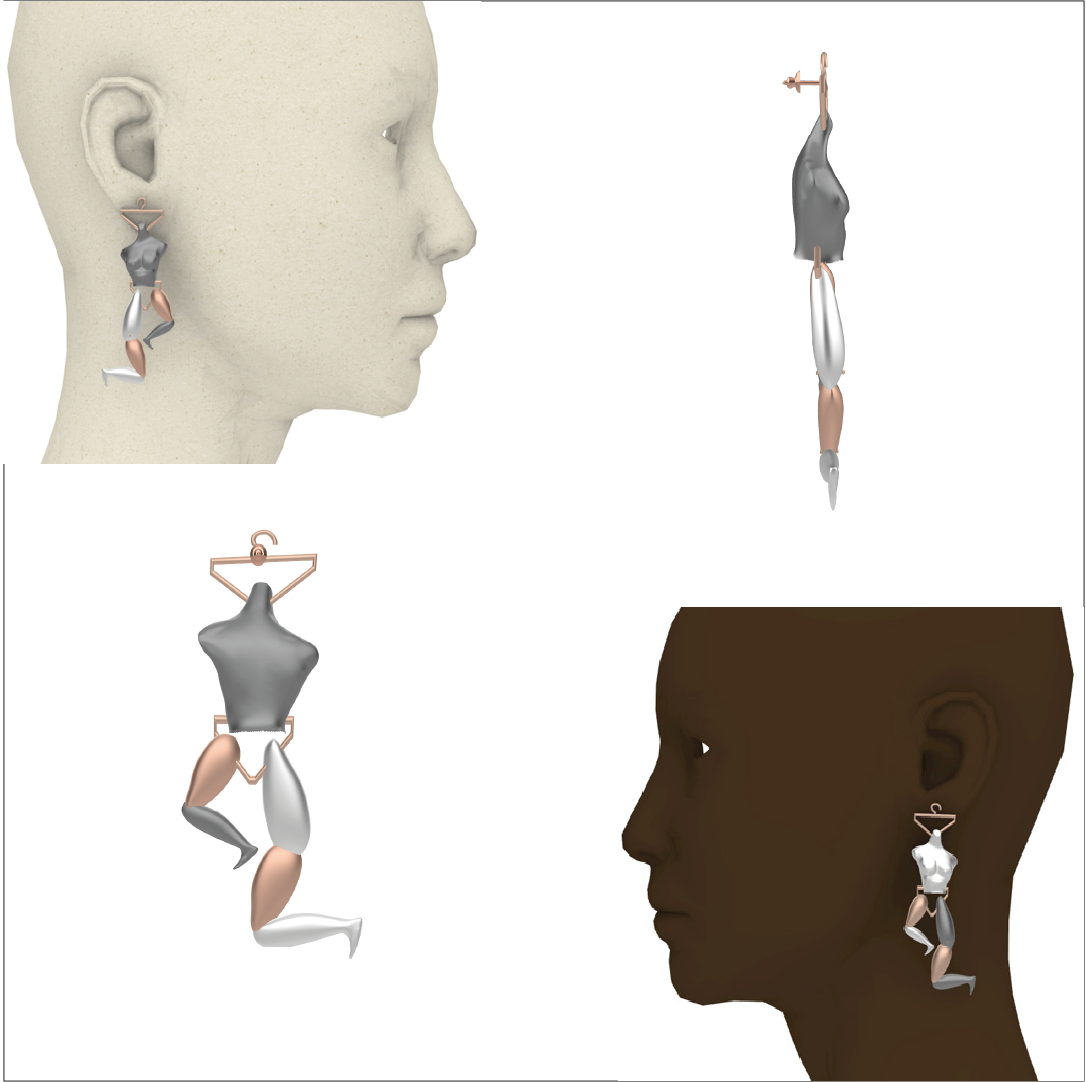2020: The Graduate Showcase
For our 2020 Elements exhibition The Scottish Goldsmiths Trust and Lyon & Turnbull are delighted to present the Graduate Showcase. In this unprecedented time we wanted to support this year’s Jewellery and Silversmithing graduates by giving them a platform to showcase a finished piece and introduce their work to the Elements audience. With thanks to our expert panel we selected nine graduates to showcase here and shine a spotlight on their hard work, innovative designs and craftmanship. There have been many challenges facing graduates of Scottish art colleges this year, whether it be access to workshops due to lockdown restrictions to not having their much anticipated physical Degree shows. We invite you to join us celebrate this work and follow these talented new makers as they develop their practice.
Michelle Currie
The Glasgow School of Art
Fe+Ag Brooch
Iron and silver brooch set with morganite in oxidised silver and 18ct yellow gold setting, silver pin and fastening with steel pin
Image by Alex Robson
Michelle Currie’s work is a celebration of her love of the beautifully interconnected realms of science and art. Merging traditional silversmithing techniques and precious stones with ferromagnetic materials containing iron particles, Michelle sculpts iron directly onto invisible field lines created by magnetic forces, capturing the explosive moments in static miniature sculptures and wearable objects. The iron used in Michelle’s degree collection varies from personally collected specimens from Scottish beaches to Ferrofluid samples created by NASA.
Michelle’s ongoing research merges her own artistic experimentation together with her interest in the cutting-edge research for the detection of gravitational waves undertaken by researchers and scientists at The Glasgow University’s Physics and Astronomy Laboratories. Combining physics and astronomy with the traditions of silversmithing and emerging creative technologies, curious wearable objects are created that promote a passion for science and art collaborations and cross-disciplinary conversations and exploration.
Iron Dance Magnetic Brooch made of iron, silver, iron oxide and resin
Iron Moon Brooch Lid and Vessel made of iron, silver, iron oxide and resin
Nebula Brooch made of silver, iron oxide, resin and glass
Yanan Li
Edinburgh College of Art
Lucky Rabbit’s Foot Brooch
Paper maché, paper fibre, stainless steel wire and mother of pearl cabochon
Image by Alex Robson
Yanan Li has always been fascinated by different jewellery materials. She believes that even the simplest materials can be precious and cherished for years to come and because of this felt inspired to investigate the properties and limitations of paper. Through this process of exploration Yanan was fascinated by the results she had created when combining different types of paper. With a passion for working with precious and semi-precious stones, Yanan wanted to push the boundaries with this material, removing the need for adhesives and chemical bonding, allowing the material to adhere securely with precious metals and gemstones.
By pushing the capabilities of this material, Yanan has found innovative and sustainable ways to work and has developed her own paper maché material. She can adapt her paper maché ‘recipes’ to provide different textural and visual outcomes creating truly unique pieces.
Paper Maché Brooches and Earrings made of paper maché, stainless steel wire, pearl, mother of pearl, crushed lapis lazuli gemstone, pearl flakes and tourmaline gemstones
Alice Fry
The Glasgow School of Art
Blue Rock Ring
Anodised niobium and sterling silver
Image by Alex Robson
Alice Fry is a multi-award winning jeweller and silversmith who celebrated the chaotic beauty of crystal and mineral formations through the medium of metal. Having both a traditional and contemporary training in the field of metalwork and design, Alice’s work aims to re-imagine the rare mineral specimens into functional jewellery and objects without depleting their precious resource. To create these rock-like textures and forms, Alice uses the ancient technique of chasing and repoussé. On top of this technique, Alice has studied the wonderful metals titanium and niobium that allow her to add bright blue pops of colour to her collection through the modern techniques of anodising. This has become her specialism, and is one of a small handful of metalworkers in the UK working in niobium. Alice is studying at Bishopsland Educational Trust 2020-2021, which is a residential course specialising in the ancient crafts of jewellery and silversmithing.
Crystal Pendant made of anodised niobium and sterling silver
Tourmaline Box made of blue titanium, sterling silver and gold plate
Rutilated Quartz Ring made of sterling silver
Sarah Murdoch
The Glasgow School of Art
Emerge
Copper and vitreous enamel
Image by Alex Robson
Objectification can be defined as seeing and/or treating a person, usually a woman, as an object. Exploration of the female form was the starting point of Sarah Murdoch’s research, studying the evolution of beauty standards throughout the ages.
Initially, the life drawing tradition marked the beginning of her investigation; extracting form, colour and pattern directly from drawings and incorporating them into her designs. Each pose has its own fleeting image that has to be captured there and then, and can be interpreted in different ways by the viewer.
The collection presented here focuses on Western ideals of beauty and the extremity of the objectification of women in our culture. In today’s society women are under constant pressure to ‘correct’ their bodies to an ideal image, to the detriment of their mental health. Therefore these pieces form a collection of vessels focussing on the mental health crises in young women reflected in the myriad pressures society places upon them.
Working intuitively, Sarah forms straight into metal using asymmetric raising to create curved, organic shapes based on her drawings. Her use of enamel is translated using the technique, sgraffito—where the enamel is left to dry, and pattern and illustration is scratched on the surface before firing.
Consideration of colour is the fundamental groundwork of her collection. She uses bold and vibrant shades of enamel to express both hope and empowerment to a community of people who have suffered from feelings of displacement in the past.
‘The Object’ Collection made of copper, sterling silver and vitreous enamel
Scott Clark
Duncan of Jordanstone College of Art and Design
Cube(ish)
Bronze Sculpture
Image by Alex Robson
Scott Clark’s work is based on Geek Culture and how it is seen as being attracted to more technically abstract topics such as technology, gaming and science fiction. Scott’s work seeks to bring a physical representation of the internal components in everyday electronics and how the pieces of the computer are built up in complex digital layers to create a powerful piece that entrances users. Scott wants these pieces to lead the way for new techniques and skills in making as well as showing refinement in the skills already used. Through the use of digital making, looking at 3D modelling and printing, Scott creates complex pieces that use logical flipping and voxel designs found in electronics to create complex geometric pieces. The cubes created in Scott’s collection reflect an obsession with the intricacy of circuity and how the linear structure builds up to create something new and meaningful. Through the creative process, Scott would like to see the style and skills within these designs becoming more complex and erratic to show the chaotic nature of circuitry and electronics. These cubic designs play with scale and size to create a collection that can be linked back to Scott and recognised as a unique style and form by like-minded people that share a connection to the geek culture.
Cubic Sculptures 3D rendered in silver and gold
Prototype of Knuckle Ring in silver
Design and technical drawing for Bronze Brooch
Kelda Young
Duncan of Jordanstone College of Art and Design
Tactile Brooch
Recycled 925 sterling silver
Image by Alex Robson
Kelda Young’s work is inspired by recollected fragmented memories that have been materialised through photography and condensed into abstract shapes through the medium of collage—celebrating the contrast and similarities between the man-made and natural. Inspiration is also drawn from rare moments of serenity that she has experienced.
The resulting imagery is translated into bold designs in the workshop where Kelda finds refuge in the physical act of making. This is equally as important as the outcome—it is here that she finds herself fully submerged in the process. Sustainable practices and responsible material sourcing are fundamental to Kelda’s work. She uses recycled aluminium to cast hand carved rings as it is unpredictable and can result in beautiful surface finishes from the casting process. She also uses recycled sheet metal to build hollow forms that allow her work to push the boundaries of scale, but can still be worn comfortably. These pieces are intended to be wearable mini sculptures, allowing interpretation by the user.
Most recently, Kelda’s work incorporates embossing to create surface patterns highlighting textures and details that might often go unnoticed. The softness of the pushed metal is enticing and invites the wearer to physically engage with the piece.
Kelda’s collection brings structure to memories, allowing them to be preserved through materialisation. The fabrication of these pieces creates a place for them in her physical world.
Details Brooch, Linear Ring and Cubic Ring made of hollow formed recycled 925 sterling silver
Magenta Hollow Brooch and Ring made of hollow formed recycled 925 sterling silver and concrete tinted with recycled printer toner
Step Series I, II made of recycled aluminium
Hayley Irving
Duncan of Jordanstone College of Art and Design
Small but jesmonMIGHTY Rings
Jesmonite, plastic and wood
Image by Alex Robson
It all started at 194.
‘An Englishman’s home may be his castle but a Scot wummin’s hame is her close’.
Hayley Irving grew up living with three generations of women under one tenement roof. Some of her earliest memories of her Gran Marion include her shouting down the close stairs every Friday night': ‘Get oot the close or I’ll phone the polis’.
That was her life living in Possilpark, one of Glasgow’s most deprived areas, due to the decline of industry within the city. Possilpark is currently associated with crime, drug abuse and property.
Irving’s attitudes towards materials and making jewellery come from living in a place filled with poverty and sadness, alongside living with her mum and gran who always made the best out of a bad situation. She can see beauty in objects and materials others may regard as rubbish.
Irving is inspired by derelict buildings and graffiti from her walks to school and uses materials such as wood, resin, jesmonite and stones recycled from old costume jewellery to create a variety of bold colourful pieces.
With the use of sublimation print, Irving can bring in family photos allowing her to express her stories and memories of life in a female dominated household. Just press buzzer 2/1 and she will let you into 194 Saracen Street.
‘Yer a Gem’ Earrings made of plastic, aluminium, resin and copper
‘Sassy Lassy’ Brooch made of wood, aluminium, plastic, jesmonite and copper
‘Raised in these tenement walls’ Earrings made of copper, aluminium and plastic
Nicholas Harrington
City of Glasgow College, HND
Spinner Pendant
Silver and Steel
Image by Alex Robson
Nicholas Harrington is an artist and jewellery designer based in Glasgow.
Proportion, balance and simplicity are recurring themes in Nicholas’ work. The design brief for a recent jewellery collection was titled ‘A Sense of Place’. Trips to Japan have made a lasting impression, and the sophisticated design and exquisite craftsmanship to be found there is a continual inspiration. He is particularly interested in how this same influence shaped what we call the ‘Glasgow Style’ of Mackintosh et al, as well as countless other international avant-garden modern movements. An interest in Zen Buddhism has taught him to appreciate the ‘empty’ space between things, or what is unsaid as much as what is said.
Nicholas always enjoys working with silver, whose characteristics continually delight and fascinate. Likewise, stone setting has become a particular area of focus. He is interested in capturing a feeling of movement and expressing the balance and tension between positive and negative space, solid and void, darkness and light. How a stone is supported and held in place, its relation to the body and how it interacts with light is key.
Nicholas thinks of jewellery as a process of rearranging materials which have been in the earth for millions of years and will be here long after us. As the Ethical Making ambassador for City of Glasgow College, he learned a lot about where materials come from and how they can be used and re-used responsibly.
Brooch made of silver, enamel and gold leaf
Brooch made of silver, gold, carnelian and onyx
Render of Teapot made of silver and walnut
Daniela Groza
Edinburgh College of Art
Jewellery is not just aesthetics. Daniela’s objective is to address important social, moral and even political issues happening around the world and design jewellery with strong visual impact that people can relate to.
This collection aims to promote inclusivity, highlighting the beauty of diversity and individuality within one’s body and skin tone. Materials celebrate colour through the use of mixed metals. The use of Japanese Mokume-gane technique of blending and laminating different metal alloys to create marbled surfaces illustrates the beauty of skin imperfections.
Tracing metals back to their natural source is becoming more pertinent to the industry. Sustainability is a feminist issues. The women at the beginning of the jewellery supply chain are often the victims of abuse, unfair pay and discrimination. Daniela is committed to using recycled materials in my collection, from silver scrap collected through time to gold reclaimed from family heirlooms. The abstracted limbs offer the wide spectrum representing the female form: body parts with diverse proportions, including lumps, bumps and stretch marks.
Due to unforeseen circumstances, Daniela was unable to produce her selected piece for the Graduate Showcase but we are pleased to be able to include her work.
Renders of Graduate Collection
We would like to express our thanks to the selection panel of the 2020 Graduate Showcase:
Sarah Rothwell, Curator of Modern & Contemporary Design at National Museums Scotland
Kirsty Sumerling, Director at The Scottish Gallery
Stacey Hunter, Curator of Local Heroes
Ebba Goring, Director of The Incorporation of Goldsmiths
Leah Black, Chief Executive of WHALE Arts and Warden of The Incorporation of Goldsmiths
Jewellery and Silversmithing is an exciting, practical, studio-based programme teaching students to design and make thoughtful, well-made and considered work. The J&S department is small and friendly with a big international reputation as one of the UK's leading courses in the field. We offer both undergraduate BA Hons and post graduate MFA programmes of study. We balance old and new approaches to traditional craft techniques with innovation, exploration and cross-disciplinary collaboration. Our objective is to design critically informed work that integrates ‘thought’ and ‘practice’ to contribute towards the ever-evolving creative industries within and outwith our discipline. Our objective is to enable students to design and create personal, individual pieces of work that push the boundaries of our subject.
The department is fundamentally concerned with instilling knowledge of materials and making practices. We use materials experimentally. We express ideas through materials and seek out new ways to apply them. We have a philosophy that encourages a wide range of approaches, from the traditional Gold and Silversmiths’ trade, to the contemporary influences of art, craft, design, technology and science. We work hard to prepare graduates with a realistic understanding of the wider industry and career opportunities. International exchange opportunities and live projects enable students to gain a greater understanding of the industry and craft. A balance of projects enables students to design and develop a jewellery collection for a selling exhibition and to work with new technology alongside traditional techniques and processes.
By immersing our students in cutting edge technology as much as traditional skills, we help them to challenge convention and develop their own vision of what a designer can be. They address contemporary issues linked to materials, sustainability and the emerging dichotomy between the digital and the handmade. The latter is a major focal point, with students being encouraged to experiment with digital making, computer-aided design, and wearable electronics as well as learning more hands-on making techniques. Jewellery & Metal Design is about much more than aesthetics, while these collections may well be beautiful, they are also the result of extensive research and deep reflection on contemporary issues such as travel and adventure, personal identity, political and spiritual beliefs, mental health and wellbeing, and the natural and the built environment. Graduates from this programme work in varied careers. They work as artists and designers. They can be found in management, education, or in specialist posts within museums and galleries. Wherever they are and whatever they do, they display the versatility and innovation that are characteristic of a true designer.
This course teaches a comprehensive range of skills with a design-led focus. We focus on marrying new technology with traditional techniques – pushing boundaries of material exploration, and developing skills in emerging technologies with access to Laser cutting and 3D Printing. Using a wide range of materials, processes and concepts students develop innovative design skills. We work closely with industry partners to deliver live projects and briefs and compete successfully in National competitions. Award-winning and leading the way in ethical practices and sustainability in industry, this course enables learners to leave a responsible maker and contribute to the Circular Economy.
The Silversmithing and Jewellery programme at Glasgow School of Art aims to provide a broad, balanced approach to the specialism, from the development of original design concepts through to finely crafted finished work. A strong emphasis is placed on the development of individual skills, allowing students the freedom to pursue and realise their own ideas. Encouraging the exploration of materials and concepts in order to create their own voice.
Gray’s School of Art three dimensional design course provides a broad and rich period of study that allows students to explore a wide range of ‘design/craft disciplines’ including jewellery, ceramics, glass and product design. Students are encouraged to gain hands-on crafts and design experiences using innovative materials and techniques. Students are taught traditional design and drawing skills alongside CAD and modern technologies. During the final two stages students specialise within their chosen disciplines allowing them to focus on their preferred area of research and reach their fullest potential. Students specialising in jewellery will experience a broad range of metal techniques from stone setting, surface decoration and jewellery techniques to larger scale silversmithing pieces. As well as a four year BA Honour course we also offer fulltime and part-time MA specialising in jewellery as well as PhD research positions.
At Glasgow Kelvin College we pride ourselves on delivering up to the minute industry-appropriate skills education at all levels from NC to HND. We are proud of the way in which we have taken on board the new technologies of CAD and Advanced CAM such as digital milling and 3D printing. We are the only Scottish college delivering Gemvision Matrix training. Our courses seek to integrate these skills into the traditional base of skills required by the modern goldsmith. Our courses include Gemmology, Advanced Stone setting, Optical Diamond mounting, 3D Printing for jewellery and Advanced lost wax casting.
Jewellery at Fife College offers NC and HND giving the students the opportunity to gain a wide range of specialist skills in the jewellery making process. Projects are design led with an emphasis on experimentation and creativity at the sample stage. Specialisms covered include alternative materials, stone setting, enamelling, forming, lost wax casting and CAD. Students can either progress to BA(Hons) Degree courses in Jewellery design at other Scottish Universities - Glasgow, Edinburgh, Dundee and Aberdeen - or progress straight into employment/self-employment as a maker or designer in industry.

